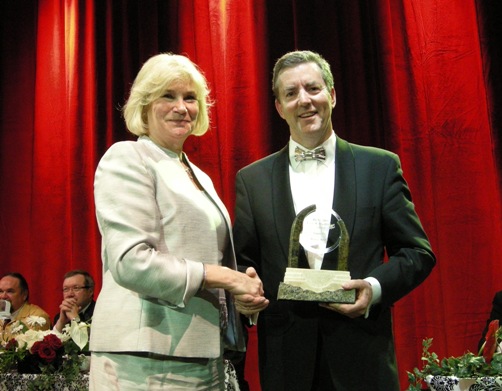Paul Stothart is vice-president, economic affairs of the Mining Association of Canada. He is responsible for advancing the industry’s interests regarding federal tax, trade, investment, transport and energy issues. www.mining.ca This column was originally published November, 2009. This column was originally published in February, 2009
To mining company managers, an economic downturn is old hat. Typically, a few years of economic growth lead to a year or two of stagnation and low mineral demand and prices. Mining projects are put on hold until the price and availability of labour and materials return to a sound
footing. Other variables, such as wars, strikes and technological shifts can exacerbate or mitigate this cyclical movement of mineral prices.
The current economic turmoil, however, is not a traditional business cycle. Yes, the real economy is slowing in a traditional manner. Manufacturing is in recession and high overheated costs have dampened investment in natural resource development. Falling mineral and stock
prices have made the raising of new equity capital and exploration financing unfeasible.
In Canada and overseas, mine development has been postponed or cancelled and companies have entered a “batten down the hatches” mode. Credit Suisse estimates that $50 billion in capital spending in mining — two-thirds of announced global commitments — would be delayed in 2009. Beyond this cyclical slowness, though, two new variables make the present downturn tougher to gauge and recovery time frames more difficult to predict.

























 Michael Barnes is the author of more than fifty books about characters, communities, mining, and police work. He is a Member of the Order of Canada and makes his home in Haliburton, Ontario, Canada. While living in Northern Ontario most of his life, he has come to know and admire those who make their living in the mining industry.
Michael Barnes is the author of more than fifty books about characters, communities, mining, and police work. He is a Member of the Order of Canada and makes his home in Haliburton, Ontario, Canada. While living in Northern Ontario most of his life, he has come to know and admire those who make their living in the mining industry. Michael Barnes is the author of more than fifty books about characters, communities, mining, and police work. He is a Member of the Order of Canada and makes his home in Haliburton, Ontario, Canada. While living in Northern Ontario most of his life, he has come to know and admire those who make their living in the mining industry.
Michael Barnes is the author of more than fifty books about characters, communities, mining, and police work. He is a Member of the Order of Canada and makes his home in Haliburton, Ontario, Canada. While living in Northern Ontario most of his life, he has come to know and admire those who make their living in the mining industry. Michael Barnes is the author of more than fifty books about characters, communities, mining, and police work. He is a Member of the Order of Canada and makes his home in Haliburton, Ontario, Canada. While living in Northern Ontario most of his life, he has come to know and admire those who make their living in the mining industry.
Michael Barnes is the author of more than fifty books about characters, communities, mining, and police work. He is a Member of the Order of Canada and makes his home in Haliburton, Ontario, Canada. While living in Northern Ontario most of his life, he has come to know and admire those who make their living in the mining industry. Michael Barnes is the author of more than fifty books about characters, communities, mining, and police work. He is a Member of the Order of Canada and makes his home in Haliburton, Ontario, Canada. While living in Northern Ontario most of his life, he has come to know and admire those who make their living in the mining industry.
Michael Barnes is the author of more than fifty books about characters, communities, mining, and police work. He is a Member of the Order of Canada and makes his home in Haliburton, Ontario, Canada. While living in Northern Ontario most of his life, he has come to know and admire those who make their living in the mining industry. Michael Barnes is the author of more than fifty books about characters, communities, mining, and police work. He is a Member of the Order of Canada and makes his home in Haliburton, Ontario, Canada. While living in Northern Ontario most of his life, he has come to know and admire those who make their living in the mining industry.
Michael Barnes is the author of more than fifty books about characters, communities, mining, and police work. He is a Member of the Order of Canada and makes his home in Haliburton, Ontario, Canada. While living in Northern Ontario most of his life, he has come to know and admire those who make their living in the mining industry. CHECK AGAINST DELIVERY
CHECK AGAINST DELIVERY
 The PDAC Viola R. MacMillan is named after the PDAC’s longest serving president. It honours a person who has demonstrated leadership in management and financing for the exploration and development of mineral resources.
The PDAC Viola R. MacMillan is named after the PDAC’s longest serving president. It honours a person who has demonstrated leadership in management and financing for the exploration and development of mineral resources. The PDAC Distinguished Services Award recognizes an individual for one or more of the following: substantial contribution to the mineral exploration and mining development; considerable time and effort expended on behalf of the PDAC; outstanding contributions to the industry in finance, geology, geophysics, geochemistry research, or a related activity.
The PDAC Distinguished Services Award recognizes an individual for one or more of the following: substantial contribution to the mineral exploration and mining development; considerable time and effort expended on behalf of the PDAC; outstanding contributions to the industry in finance, geology, geophysics, geochemistry research, or a related activity. The PDAC Skookum Jim Award is named after Skookum Jim, the Aboriginal leader of the group that discovered the Yukon Klondike goldfields, one of Canada’s most important mineral discoveries. Recipients of this award will have demonstrated exceptional achievement and/or service in a Canadian Aboriginal-run service business for the Canadian mining industry or a Canadian aboriginal exploration or mining company or made a significant individual contribution to the mineral industry either technically, through a business venture, or through a mineral discovery.
The PDAC Skookum Jim Award is named after Skookum Jim, the Aboriginal leader of the group that discovered the Yukon Klondike goldfields, one of Canada’s most important mineral discoveries. Recipients of this award will have demonstrated exceptional achievement and/or service in a Canadian Aboriginal-run service business for the Canadian mining industry or a Canadian aboriginal exploration or mining company or made a significant individual contribution to the mineral industry either technically, through a business venture, or through a mineral discovery. The PDAC Environmental and Social Responsibility Award recognizes an individual or organization demonstrating outstanding initiative, leadership and accomplishment in protecting and preserving the natural environment or in developing good community relations during an exploration program or operation of a mine.
The PDAC Environmental and Social Responsibility Award recognizes an individual or organization demonstrating outstanding initiative, leadership and accomplishment in protecting and preserving the natural environment or in developing good community relations during an exploration program or operation of a mine.